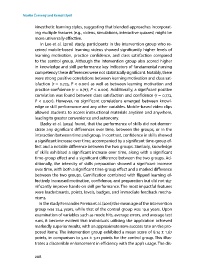Page 208 - International Perspectives on Effective Teaching and Learning in Digital Education
P. 208
Martin Červený and Kemal Elyeli
kinesthetic learning styles, suggesting that blended approaches incorporat-
ing multiple features (e.g., videos, simulations, interactive quizzes) might be
more universally effective.
In Lee et al. (16) study, participants in the intervention group who re-
ceived mobile-based learning videos showed significantly higher levels of
learning motivation, practice confidence, and class satisfaction compared
to the control group. Although the intervention group also scored higher
in knowledge and skill performance key indicators of fundamental nursing
competency these differences were not statistically significant. Notably, there
were strong positive correlations between learning motivation and class sat-
isfaction (r = .75, P < .1) as well as between learning motivation and
practice confidence (r = .717, P < .1). Additionally, a significant positive
correlation was found between class satisfaction and confidence (r = .77,
P < .1). However, no significant correlations emerged between knowl-
edge or skill performance and any other variables. Mobile-based video clips
allowed students to access instructional materials anytime and anywhere,
leading to greater convenience and autonomy.
Elzeky et al. () found, that the performance of skills did not demon-
strate any significant differences over time, between the groups, or in the
interaction between time and group. In contrast, confidence in skills showed
a significant increase over time, accompanied by a significant time-group ef-
fect and a notable difference between the two groups. Similarly, knowledge
of skills exhibited a significant increase over time, along with a significant
time-group effect and a significant difference between the two groups. Ad-
ditionally, the intensity of skills preparation showed a significant increase
over time, with both a significant time-group effect and a marked difference
between the two groups. Gamification combined with flipped learning ef-
fectively increased motivation, confidence, and preparation but did not sig-
nificantly improve hands-on skill performance. The most impactful features
were leaderboards, points, levels, badges, and immediate feedback mecha-
nisms.
In the study Fernandes Pereira et al. (16) the mean age of the intervention
group was .4 years, while that of the control group was 19.9 years. Upon
examination of variables such as mode hits, average errors, and average test
runs, it became evident that individuals utilising the application achieved
markedly superior results, with an approximate 8% success rate on the pro-
posed items. The intervention group exhibited a mean score of 8.14 ± 1.67
points, in comparison to 5. ± 3.1 points for the control group. This illus-
trates a discernible enhancement in efficiency with the app’s usage. The dis-
8

